Dawn broke and the Soviets had landed on the far bank. Could they keep it?
 |
| The Soviet left pushes inland. |
 |
 |
| Boom |
 |
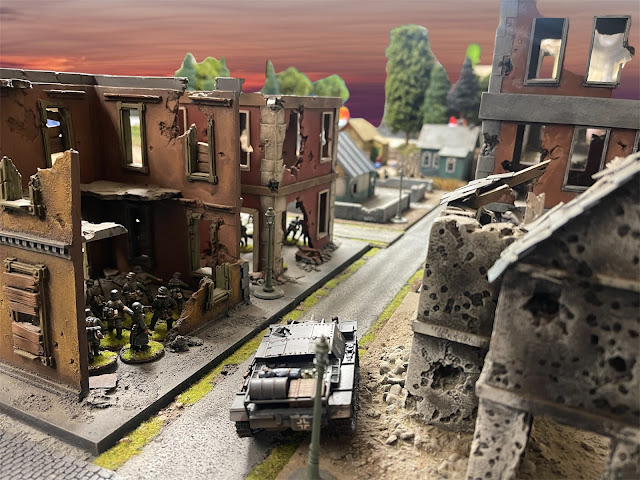 |
| Worse |
 |
| Entering the city. The Soviet view |
Soviet Army Morale-26 (starting 35)
German Army Morale 20 (starting 20)
Dawn broke and the Soviets had landed on the far bank. Could they keep it?
 |
| The Soviet left pushes inland. |
 |
 |
| Boom |
 |
 |
| Worse |
 |
| Entering the city. The Soviet view |
Soviet Army Morale-26 (starting 35)
German Army Morale 20 (starting 20)
In the pre-dawn darkness the Soviet troops quietly carried their assault rafts to the banks of the small river. The German advance troops posted up on the far bank and waited for reinforcements to come up for the next day’s assault, not realizing the Russians had beaten them to the attack.
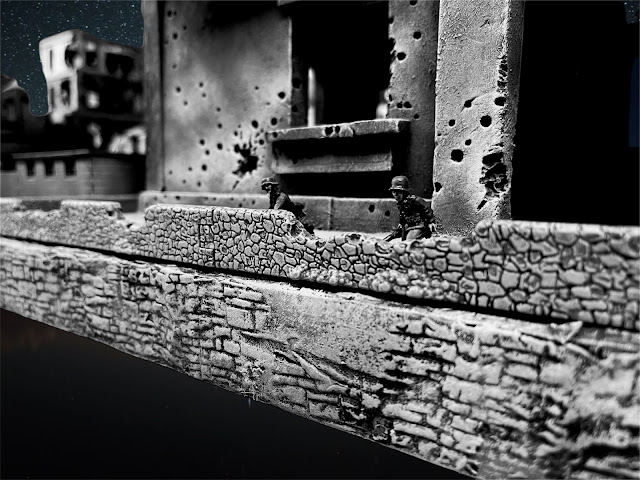 |
| All Quiet… |
The Hungarian sentry detachment was posted up on the Axis right with a Junior Leader manning a searchlight. Two German sentry teams held the middle and left. A Second Searchlight stood by the larger bridge. The three Soviet Jump Off Points were evenly spaced out on the opposite bank; one in the woods on Soviet left, one behind a small dacha in the middle, and a third behind a church on the right.
 |
| Unloading and preparing to cross |
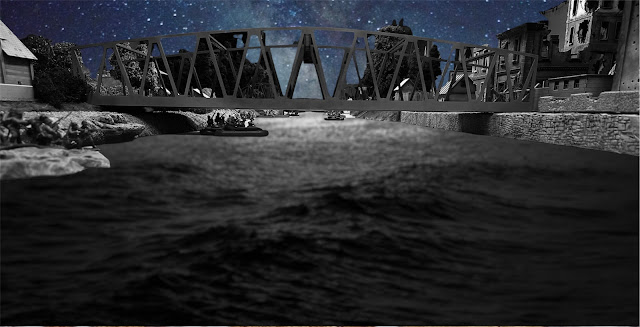 |
| The crossing progresses. |
 |
| The motivated raft can barely be seen beyond the bridge like a khaki Loch Ness Monster |
Sure enough, the Hungarian-manned searchlight caught the advancing raft in its beam at the same time a German sentry on the far flank sighted another pair of rafts. The alarm howled; but was it in time? The first raft struck dirt on the Russian left and the squad disembarked onto dry land, scaring the lone Hungarian into bolting for the rear. The Russian invasion had begun.
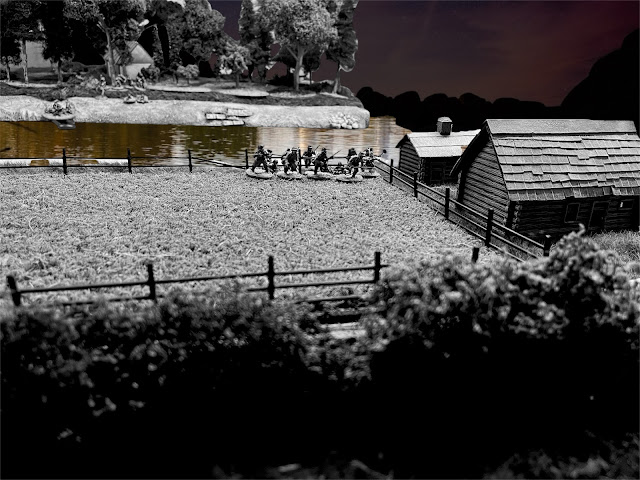 |
| Land Uurah! |
The alarm bells triggered an immediate response from the God of War and Russian shells rained down on the German defenders.
Game Note: In this scenario the Soviets were given a delayed preliminary bombardment that could delay Axis reinforcements. Although short lived, this one was effective)
The Hungarians were undaunted by the falling shells and deployed to meet the first landing party. A panzer 3F was also able to arrive to support the Axis right flank. All along the front the Russians were able to make landfall with minimal resistance due to the covering fire of the artillery.
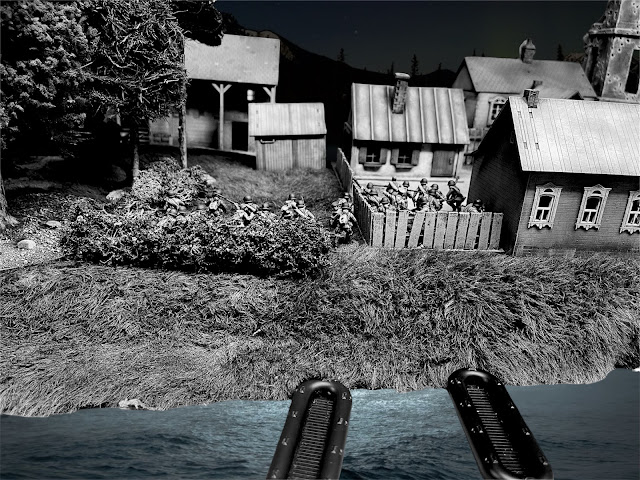 |
| For example…in the middle |
The barrage, although effective was short. The Germans brought an end to the barrage and the start of the dawn (they rolled three sixes to activate) and deployed from their bivouacs to meet the threat.
On the far Axis right an unlucky Serzhant leading his men across a wheat field was first wounded by a Hungarian bullet and then killed by a German bullet. Otherwise, casualties were low.
 |
More rafts landed in front of the built up area on the Soviet right and in the village in the middle. Several brave squads even pushed across the bridges.
Next came the highlight of the session and an excellent example of why 1941 was a good timeframe for WW2 wargaming.
A very brave T-26 Soviet light tank raced across the smaller bridge. An equally brave Hungarian Toldi tank rolled up on the opposite side of the bridge. The Toldi claimed the first shot…and missed. It shot again…and missed. The T-26 halted and fired..and missed. Hungarian reinforcements arrived in the form of a Csaba armored car which pulled up next to the Toldi tank The Toldi fired and scored a hit…that bounced off the T-26. The Csaba blasted away and also hit..which bounced off the T-26. The war of the ineffectuals had officially begun.
 |
| This could take a minute |
The battle was now on.
The first phase of the fight was over, and the second phase was about to begin. The Soviets had a full six squads on the enemy bank with minimal casualties but there was a long way to go.
Soviet Army Morale-32 (starting 35)
German Army Morale 20 (starting 20)
The Soviet repulse of Axis forces attempting to force a crossing at one of many rivers did not stop at Axis Juggernaut. Soon the German and Hungarian armies of the Southern Front worked around the Russians defending the river crossing and scooped up thousands of prisoners. July 1941 was coming to a close and Uman was on the horizon.
The Germans and Hungarians again came to the banks of another one of the ubiquitous rivers south of the soon to be encircled Uman. Advanced units reached the river near a now forgotten city and easily pushed the Soviets back across the river. The main body of Axis forces and artillery were called up and en-route, but before any attack could be staged the Soviets pounced first…
 |
Every time an attacker does one of the following the defending side rolls 1d6
@-Infantry moves at any speed but At the Double- cannot be heard
@-Infantry moves at the double-1-2 defender hears and sounds alarm
@-Vehicle moves at normal speed 1-2 defender hears and sound alarm
@-vehicle moves flat out 1-4 defender hears and sounds alarm
@-tank moves any speed Automatic defender hears and sounds alarm
@-Attacker fires weapon. Automatic defender hears and sounds alarm
@- Attacker assaults defender team - roll 1d6. If the number rolled is equal to or lower than the number of dead defenders alarm is sounded. If any defender survives a round of combat they will automatically sound the alarm.
- Spotting Attackers. Any time an attacking squad, vehicle or gun team is in spotting range of a defender who activates; or an attacking squad, vehicle or team is spotted by a searchlight, place a marker by the spotted team. A defending squad or team can spot more than one attacking squad or team in the same phase representing an increased chance of seeing multiple squads sneaking by. An attacking squad or team can be spotted by multiple defenders and have more than one marker placed on it.
At the end of the next phase whether attacker’s-or in the case of a double phase roll-defender’s, the attacking player rolls a D6 for each marker next to a squad or team.. The attacker can increase or decrease the chance of being spotted by what action they take or don’t take during the phase directly after being spotted.
Member Infantry standing still or not activated spotted on roll of 1
Infantry moving tactical spotted on roll of 1-2
Infantry moving anything else on a roll of 1-3
Vehicle standing still spotted on roll of 1-2 (tanks are automatically heard)
Vehicle moving spotted on 1-4 (tanks are automatically heard)
Assault raft floating spotted on a roll of 1
Assault raft actively rowing spotted on a roll of 1-2
-Searchlight: The searchlight acts a bit differently. Any Searchlight on the board (there are two in this scenario) can be activated by a sentry team on a roll of a one (or three if ordered by a Junior Leader) When activated, a handy paper template is placed on the front of the searchlight (the template is a sleek design) and a dice is rolled to indicate which direction the spotlight is facing. A two inch wide beam is projected out 24” in the indicated direction. If the beam crosses an enemy model without being blocked by scenery there is a chance the model will be seen and the alarm sounded. We used the shorter beam to allow the attackers to at least be able to reach the river before being spotted as happened last game.
 |
| Only the finest tools will do |
Sounding the Alarm- The alarm is always sounded at the end of the phase in which a model is heard or seen.
The German steamroller plowed on into the Russian interior. Army Group South encircled numerous Soviet armies and appeared unstoppable. Local Soviet forces resisted but were either crushed or bypassed as Von Rundstedt pursued his goal. The Soviets under General Tyulenev attempted to blunt the attacks and use terrain to do so. Rivers are hard to cross for an army. Defended rivers are very hard to cross.
While the Bug and Dniester were major river crossing operations there were also smaller crossings.
 |
The typical method of crossing rivers involved heavy artillery and air power. This was effective but does not necessarily make for a tactically interesting game. We decided to use stealth. In doing so we had to come up with some additional rules. There is always a risk that without playtesting we could end up with a lopsided or disaster of a game. Luckily, we embrace disaster.
The objective of the scenario is for the Germans to seize and destroy the bridge demolition equipment hidden in one of the river front houses before the Soviets could blow the bridge. They have three natural turns ( those not ending by COC dice) after the alarm sounds to do it.
The attack starts pre-dawn in darkness. Light arrives at the end of three natural turns.
The Soviets start with only a few pairs of sentries and a Junior Leader. A Jump off Point located near the bridge is inactive until the alarm is sounded. Three additional JOPs are located at Russian table edge also inactive
The Germans have four jump off points at their own table edge. These will be inactive until the alarm is sounded The Germans also have a batch of half tracks and trucks. These start the game entering the table on the German side They each can carry a squad or Machine Gun team and also assault rafts
Visibility is limited to 16” but the Soviets have flares and a search light. By using a COC die the Soviets can send up a flare and double the visibility to 36” until either the turn ends or the Germans use a COC die to extinguish the flare (it was a dud.)
The search light acts like a flare but is directionally specific. A random die roll will aim the searchlight. A COC die will allow for a more specifically placed beam.
Flares and searchlights don’t mean automatic sighting Whispers of “get down” and “make like a statue” might enable detection to be avoided. Vehicles and moving troops are more easily spotted and heard.
The Board
 |
| The possible objectives and Jump off points |
The Germans could also go for the bridge but this is a more open route subject to being spotted. If the Germans rush the bridge they could catch the Soviets napping (literally) but it’s likely they would be seen or heard and the alarm sounded.
The Battle
The German (and Hungarian) attack would be stealthy Six half tracks and three trucks crawled slowly forward, loaded with assault rafts and soldiers. (Suspend belief-these are very quiet half tracks if moving at slow speed.)
The Soviets placed their four sentries led by a Junior Leader near the bridge and Searchlight. The rest of the Russians snoozed away.
 |
| Everything is black and white at night. Look it up. |
The Axis troops spread out. Three half tracks drove for the woods while the trucks carrying the Hungarians and three other half tracks drove up the road and kept to the left. Immediately a turn end was rolled. Two more turns and it would be light
 |
Everything was going smoothly for the attackers when they again rolled an end of turn. Only one more turn until daylight.
The Germans entered the woods to the right and quietly unloaded the rafts Two squads of infantry and a medium machine gun crew would try to quietly slip across the river to the shelter of woods on the far side. The other six transports became tangled in a traffic jam and moved very slowly up the road and a yard to the right of the road.
Just as the rafts were about to touch water the searchlight popped to life and threw a beam of light into the woods. The Germans froze to avoid detection but through the miracle of rolling a one, a soon to be highly decorated (possibly posthumously) sentry spotted the Germans and the alarm was sounded.
The stealthy advance was over. The Soviets roared into action. Infantry poured from bivouacs in the rear of the riverside village and raced for the river.
A Maxim machine gun crew that was playing cards (probably) in the village poured out of one of the houses and was quickly throwing fire at the Fritzes in the woods.
The Maxim was highly inaccurate in its firing at the lit up Germans. Elsewhere the Axis forces dropped the stealth and rushed forward. Even though the alarm was now sounded it was still too dark to see anything. In an effort to keep it that way the Germans in the woods and a newly arrived pair of German tanks tried to shoot out the searchlight. They failed…multiple times.
The Soviets were now on the move. Infantry platoons rushed towards the river and a dreaded KV-2 (and a not so dreaded BT-7) showed up.
Note: For this campaign a high tech 21st century method was deployed. Three giant envelopes-one for each army-were filled with pieces of paper each representing one of the tanks or towed anti tank guns in the group’s collection. Before the start of each battle players draw two slips of paper to represent available assets. If a tank is destroyed in battle its slip of paper is removed from the envelope The KV-2 (of which there are two) has been pulled for both battles. So far only one of the five T-26s has been pulled. Two of three 38Ts in German service have been destroyed so far…by the KV-2.
The Soviets were waking up and pushing forward towards the river.
Note: it was at this time a discussion halted the game and numerous modifications to rules were discussed. With so many new rules there were bound to be miscalculations and this was coming to fruition. The biggest issue was that one of the group has a nasty habit of rolling sixes in droves and ending turns. This means that much more quickly than usual turns were ending We could go (real life) weeks without anyone rolling three sixes and ending a turn. In this game three turns were ended by rolls an hour into the second week of the game. We also addressed changing searchlight rules and Jump Off Placement rules.(more on this in another post….)
And so it was that the sun rose and the Axis was way behind schedule. The rafting Lancers were still on the near bank and the Hungarian trucks were barreling towards the bridge and the very frightening KV-2.
 |
| Who leads an assault with trucks? |
The trucks were in a bind so why not hit the gas? A rare double turn allowed the first truck in line to disgorge a squad of Hungarians who immediately rushed forward to sweep up two sentries and take cover behind a large building that was immediately to their front. The second and third truck tried to tuck in behind the first truck.
Next came the moment of the battle. It seems there is one of these in every fight. The KV-2 took aim and fired at the second truck in line. A hit was scored. A high explosive shell crashed into the truck and the Soviet tank rolled its 13 dice. Rolling two fives was bad for the truck, rolling three was lethal. Instead every soldier who could see the event watched as a very large shell poked a clean hole through the canvas truck bed cover and exited harmlessly out the other side. A grand total of one 5 or 6 out of 13 was rolled.
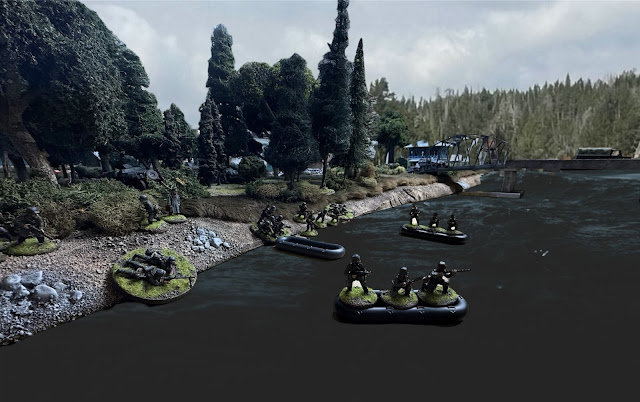 |
| Meanwhile…paddle paddle paddle. |
That was the highlight of the attacker’s night. Hordes of Soviets poured out of the village. Two infantry squads swept the disembarked Hungarians from the bank and rifle and machine gun fire did what the KV couldn’t. Bullets ripped into the second truck sending it fleeing back across the bridge with several wounded piled in the back.
The third Hungarian squad exited the last truck but was brutally dispatched by two more Soviet infantry squads who charged into them.
 |
| The fleeing Hungarian truck takes fire. |
 |
| A few more Soviets and a building containing a detonator |
Recently, we were asked about the alternating action mechanism we use to play Necromunda mentioned here . In answering that query, we real...
